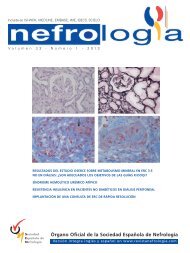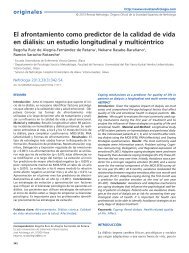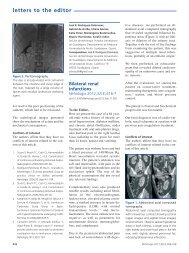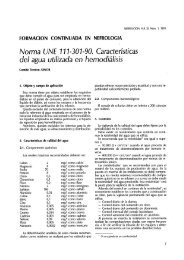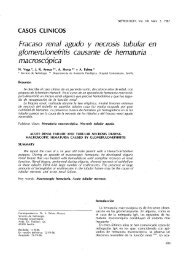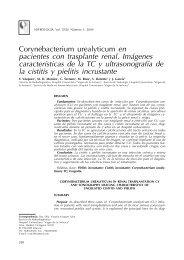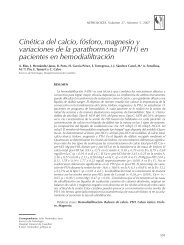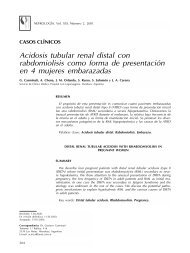PDF Número - NefrologÃa
PDF Número - NefrologÃa
PDF Número - NefrologÃa
You also want an ePaper? Increase the reach of your titles
YUMPU automatically turns print PDFs into web optimized ePapers that Google loves.
http://www.revistanefrologia.com<br />
© 2012 Revista Nefrología. Órgano Oficial de la Sociedad Española de Nefrología<br />
originales breves<br />
¿Está justificado el seguimiento ecográfico<br />
de las fístulas arteriovenosas protésicas<br />
húmero-axilares para hemodiálisis?<br />
Manuel Hernando Rydings, Guillermo Moñux-Ducajú, Isaac Martínez-López,<br />
Rodrigo Rial-Horcajo, Antonio Martínez-Izquierdo, Sara González-Sánchez,<br />
Francisco J. Serrano-Hernando<br />
Servicio de Cirugía Vascular. Hospital Clínico San Carlos. Madrid<br />
Nefrologia 2012;32(4):523-8<br />
doi:10.3265/Nefrologia.pre2012.Jan.11221<br />
RESUMEN<br />
Objetivo: Evaluar el impacto de una consulta específica de<br />
accesos vasculares (C-FAV) con seguimiento intensivo en la<br />
permeabilidad de las fístulas húmero-axilares. Pacientes y<br />
método: Estudio retrospectivo. Entre enero de 2005 y diciembre<br />
de 2009 se realizan 108 fístulas húmero-axilares.<br />
Desde junio de 2007 se establece una C-FAV. Se realiza ecodoppler<br />
preoperatorio y seguimiento posterior al mes de<br />
la intervención y, después, cada 3 meses. Resultados: Se<br />
analizan las permeabilidades de 57 fístulas húmero-axilares<br />
realizadas desde junio de 2007 hasta diciembre de 2009<br />
(grupo C-FAV), comparándolas con 51 realizadas durante<br />
los 30 meses previos (grupo control). No se encontraron diferencias<br />
en la permeabilidad obtenida entre ambos grupos<br />
a 12 y 24 meses, con una permeabilidad secundaria a<br />
los 12 meses de 49% en el grupo C-FAV y 52% en el grupo<br />
control. El porcentaje de pacientes reintervenidos fue inferior<br />
en el grupo C-FAV (35%) que en el grupo control<br />
(67%), p = 0,002. La media de reintervenciones realizadas<br />
por paciente fue menor en C-FAV que en grupo control<br />
(0,49 vs. 1,18, p = 0,01). Los pacientes del grupo C-FAV presentaron<br />
un menor número de reintervenciones por obstrucción<br />
frente al grupo control (0,42 vs. 1,04, p = 0,01).<br />
Conclusiones: En nuestra experiencia, el seguimiento intensivo<br />
no ha mejorado la permeabilidad de las fístulas húmero-axilares,<br />
disminuyendo no obstante las reintervenciones<br />
por obstrucción. El seguimiento de estos accesos<br />
debe ser clínico basado en datos de hemodiálisis, quedando<br />
la valoración ecográfica para aquellos casos con sospecha<br />
de malfunción.<br />
Palabras clave: Fístula protésica para hemodiálisis.<br />
Seguimiento ecográfico.<br />
Correspondencia: Guillermo Moñux Ducajú<br />
Servicio de Cirugía Vascular.<br />
Hospital Clínico San Carlos, Madrid.<br />
gmducaju@gmail.com<br />
Is ultrasound follow-up necessary in humero-axillary<br />
prosthetic arteriovenous fistulas for haemodialysis?<br />
ABSTRACT<br />
Aim: To evaluate through a specific trial on vascular access<br />
fistulas (T-VAF), the impact of intensive follow-up controls<br />
on the permeability of humero-axillary fistulas (Hax-AVF).<br />
Patients and method: Retrospective study. Between January<br />
2005 and December 2009, 108 Hax-AVF were implanted.<br />
From June 2007 a T-AVF was established. A preoperative<br />
duplex was performed and a follow-up control carried out a<br />
month after the intervention and subsequently every 3<br />
months. Results: An analysis was made of the permeability<br />
of 57 Hax-AVF carried out between June 2007 and December<br />
2009 (T-AVF Group), in comparison to 51 interventions<br />
performed during the previous 30 months (Control Group).<br />
No differences in the permeability achieved were found at<br />
12 and 24 months, with a secondary permeability at 12<br />
months of 49% in the T-AVF Group and 52% in the Control<br />
Group. The percentage of patients needing to be reoperated<br />
was inferior in the T-AVF Group (35%) than in the<br />
Control Group (67%) p 0.02. The re-operation per patient<br />
average was lower in the T-AVF Group than in the Control<br />
Group (0.49 vs. 1.18 p 0.01). The patients of the T-AVF Group<br />
underwent a lesser number of re-operations for obstruction<br />
as opposed to the Control Group (0.42 vs 1.04 p0.01).<br />
Conclusions: In our experience, the intensive follow-up<br />
controls did not improve the permeability of the Hax-AVF,<br />
although re-operations due to obstruction did diminish. The<br />
follow-up of these access fistulas should be clinical based on<br />
hemodialysis data, leaving ultrasonographic evaluation for<br />
those cases where a malfunction is suspected.<br />
Keywords: Prosthetic haemodialysis vascular access.<br />
Echographic follow-up.<br />
INTRODUCCIÓN<br />
Se ha producido un aumento del número de pacientes en hemodiálisis<br />
en nuestro país en los últimos años. Se estima que<br />
523



